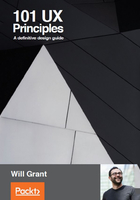
Chapter #17. Use "Infinite Scroll" for Feed–Style Content Only
Infinite scroll—where the page just keeps scrolling, loading more items asynchronously as the user hits the bottom—is extremely handy for users.
Scrolling with a mouse wheel or a touchscreen is inherently quicker, and simpler, than clicking through pages, and when the content is a news feed of Instagram photos or Tweets, it's perfect

Loading the next few items. I hope
However, infinite scroll should be limited to only a few types of content. If applied to finite lists (messages, emails, to-do items, and so on) then the user has no way of determining a beginning, middle, and end to the content. When used with this kind of content, infinite scroll is confusing and slower to use, so save it for feeds.
Although feeds used to be predominantly chronological—with the newest items first—more products (Facebook and Twitter, for example) are opting to offer users "algorithmically sorted" or "smart" timelines. The idea is (I assume) to offer users more relevant tweets or news stories at the top of their feed, and to allow promoted content like ads and sponsored posts to appear more prominently.
It may be personal taste, but I really dislike these smart timelines. First of all, they aim to serve companies and advertisers over the user, but, secondly, there is a real discoverability problem: you can't be sure what you're going to see when you open the timeline. Is it the latest item? Is it the most relevant? What happens when you navigate away and come back? Often, you're shown a new, regenerated list, making it impossible to find the item you just saw and thought you could come back to (see #19, If You Must Use Infinite Scroll, Store The User's Position And Return To It).
Whether smart or normal, infinite scroll pages have a couple of other, often overlooked, problems. They "break" the scroll bar: the scroll position on the browser window is no longer accurate and it can no longer be used to navigate up and down the page. Lastly, page footers become impossible to reach. Bear in mind.